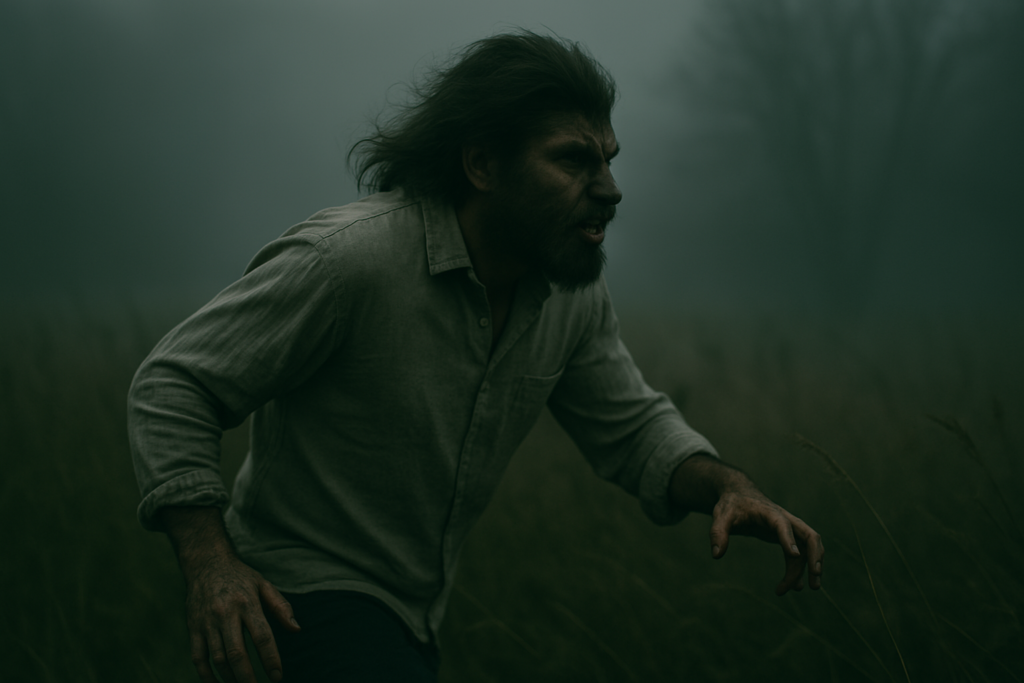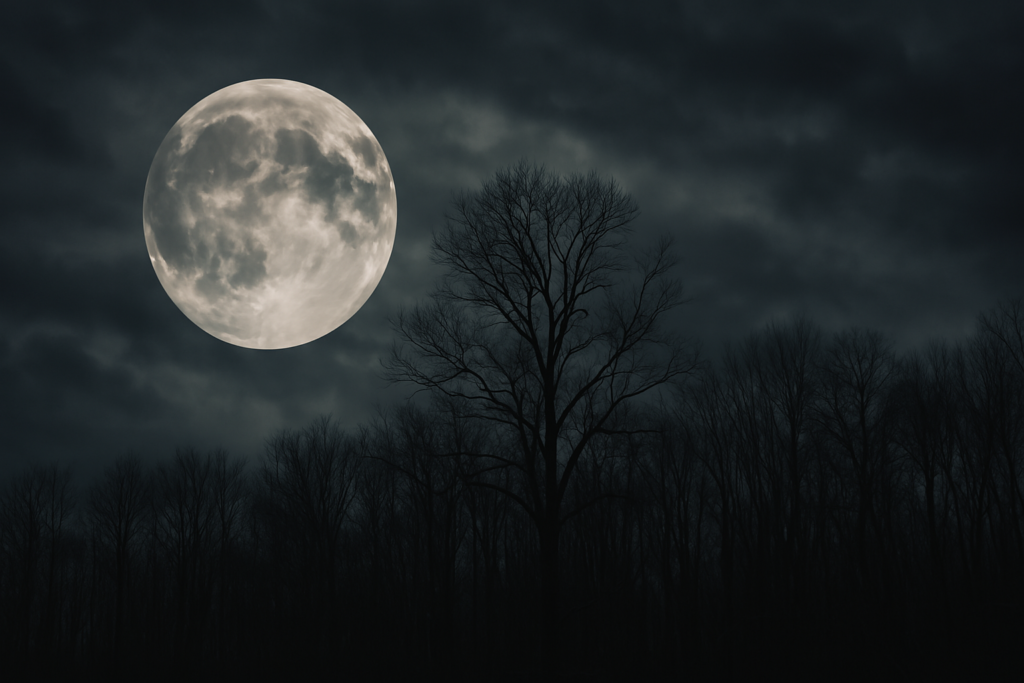1. The Full Moon Trigger Might Be Neurological

For centuries, people blamed the full moon for madness, murder, and transformation. But in modern times, hospitals, emergency rooms, and psych wards have quietly recorded something similar—surges in aggression, insomnia, and even psychiatric admissions during lunar peaks. A study from Psychiatric Services found significant increases in violent behavior among psychiatric patients during the full moon, suggesting that something primal may still respond to lunar cycles. The cause might be melatonin suppression or altered circadian rhythms, but the result is the same: strange, often violent behavior when the moon is high and bright.
What’s unsettling is how closely this mirrors old werewolf lore. In pre-industrial villages, where light pollution didn’t exist and sleep was more attuned to nature, behavioral shifts would’ve been even more pronounced. Some Indigenous cultures even described “moon-sick” people—those who wandered, howled, or turned feral with no memory of their actions. Researchers have stopped short of calling it transformation, but the link between the full moon and disturbed human behavior is still taken seriously in medical circles, especially when working in emergency psychiatry or behavioral care. It’s not about silver bullets—it’s the lunar pull on our inner animal.
2. Hair Growing in Strange Places… Might Be Real

One of the most disturbing elements in werewolf lore is the transformation—the hair sprouting across skin, the face elongating, the hands turning into paws. While exaggerated, there is a very real condition called hypertrichosis that causes excessive hair growth across the face and body. In the 16th century, Petrus Gonsalvus was born in the Canary Islands with this condition and became known as “the man with the hair of a beast,” displayed in royal courts across Europe. Today, we know it as a rare genetic mutation, but back then, it looked like a living curse. His children also had the condition, leading some to believe the “werewolf bloodline” ran in the family.
But the creepier truth lies in the psychiatric archives. In the 1800s, asylum records began to describe patients—often women—who experienced sudden hair growth following trauma, grief, or illness. There’s speculation that stress or hormonal disruption could trigger dormant genes related to body hair growth. Add to that cases of hyperandrogenism, where testosterone levels cause coarse hair to develop rapidly, and it becomes easy to see how these transformations could inspire folklore. Imagine watching someone change, slowly and unpredictably, without any understanding of biology. You wouldn’t think “endocrine disorder.” You’d think “wolf.”
3. Bite Transmission Has a Parasitic Precedent

The idea that a single bite could transform someone into a monster sounds like dark fantasy—until you look at rabies. This virus, transmitted by saliva, alters the central nervous system and leads to aggression, hydrophobia, hallucinations, and—if untreated—death. There’s also Toxoplasma gondii, a brain-altering parasite found in cat feces that makes rats attracted to their predators and has been shown to influence human risk-taking and aggression. A study in Trends in Parasitology even suggests long-term personality changes in those infected. Something tiny enters your body—and rewires your instincts.
That’s the terrifying scientific mirror of a werewolf bite. The legends describe a man who was bitten and began to change—at first slowly, but with increasing violence, mood swings, and odd cravings. In truth, both rabies and toxoplasmosis can remain dormant for weeks before manifesting in the brain. Once they do, the victim may become paranoid, erratic, or animalistic. Imagine watching a friend unravel, showing signs of something dark and primal, only to discover it began with a wound no one took seriously. If you were a medieval villager, you wouldn’t diagnose a neurological parasite—you’d chain him up before the next full moon.
4. Silver Might Wound the Mind

In folklore, silver is the holy grail of werewolf defense—capable of killing beasts no other weapon can touch. While silver isn’t magically deadly, it does have real-world power. It’s naturally antimicrobial and was used for centuries to prevent infection and purify water. During the 1800s, doctors used silver sutures and drops to sterilize wounds and treat mental illness, believing it had a calming or curative effect. But here’s the darker twist: too much silver can build up in the body, especially in the brain, potentially causing neurotoxic effects and a skin-blueing condition called argyria. The very substance thought to ward off madness might, in excess, quietly cause it.
This dual nature of silver—protective yet toxic—feeds directly into werewolf mythology. In some stories, it doesn’t just kill the creature; it purifies the soul or breaks the curse. That kind of spiritual death aligns eerily with how silver interacts with the human body, especially if used repeatedly in early psychiatric care. Victorian mental institutions experimented with colloidal silver for patients deemed “mad,” often with unpredictable results. Was it a miracle or a slow chemical exorcism? The idea that silver penetrates something deeper than flesh—the mind, the spirit—adds an alchemical horror to the weaponry. Maybe it’s not about stopping the beast. Maybe it’s about silencing what’s inside it.
5. Shape-Shifting May Be a Dissociative State

Many classic werewolf stories don’t involve fur and claws at all. Instead, they tell of men who vanished into the woods, lost time, and returned blood-soaked, dazed, and unable to explain what happened. That overlaps hauntingly with clinical lycanthropy—a rare psychiatric condition where a person genuinely believes they are turning into a wolf. Case reports dating back to the 1800s describe patients howling, crawling, and even attempting to hunt animals. In one documented case published by the Canadian Journal of Psychiatry, a man fully believed he had fangs and fur and displayed uncontrollable rage while in this altered state. The delusion often resolves with medication—but not before the person loses complete control.
Psychologists still don’t fully understand what triggers this condition. It may stem from severe trauma, dissociative identity disorders, or neurological illness—but its physicality is what’s so chilling. Many patients develop heightened senses, reject human food, and experience full fugue states. In earlier centuries, such symptoms would’ve been interpreted as possession or transformation. It’s no wonder confessions during the witch trials often included claims of becoming animals—under duress or not, the human mind is capable of conjuring monsters from within. And when a person believes they’re a predator, even if only for a night, the results can be very real.
6. Cursed Bloodlines Might Trace Back to Genetics

In countless folktales, the werewolf curse doesn’t strike randomly—it runs in families. Whole bloodlines are blamed for unnatural rage, mysterious deaths, or “animal-like” behavior under stress. Some legends even name specific clans cursed for ancient crimes, forced to live out their punishment generation after generation. Strangely, science gives that some weight. Inherited conditions like congenital hypertrichosis, epilepsy, adrenal disorders, and certain forms of psychosis can appear in lineages, sometimes skipping generations or intensifying during hormonal changes. In isolated communities, these patterns can become myths with teeth.
Now, picture a child watching her father fly into violent, irrational rages once a month—only to hear whispers that her grandfather did the same. If no one knows the word for bipolar disorder or how to treat an adrenal tumor, the only explanation is that something in the blood is turning them. In the Balkans and Scandinavia, there are still villages that avoid marrying into certain families because of rumored “wolf blood.” In parts of colonial France, priests once kept notes on parishioners whose sons were born with “wolf signs”—as if their fate had already been written. Maybe the scariest part isn’t that it’s in your blood. It’s that you can’t stop it.
7. Vanishing Bodies and the Beast Within

Many werewolf tales don’t end with a heroic kill or a grand reveal. Instead, they end in confusion: a scream in the woods, a body torn open, and no creature in sight. Just the victim—and maybe a trail of human footprints leading away. In old German and Slavic folklore, this was a common theme: the beast disappears upon death, leaving only a person behind, cursed to return to human form once the violence is done. But even modern forensic science can’t always explain certain backwoods deaths. Animal attacks in remote regions are sometimes so destructive that the culprit can’t be positively identified. And in cold, wild places, bodies change fast.
But there’s another possibility—darker, psychological. What if the person was the beast the whole time? Dissociative states, blackout rage, and fugue conditions can push people to commit acts so violent they can’t reconcile them afterward. Some soldiers returning from war have described feeling “possessed” during moments of battle—animal, disconnected, almost dreaming. And when the fog lifts, all that’s left is the aftermath. If someone came back bloodied and dazed, with no memory and no remorse, would you believe they snapped? Or that something else took over for a while? Some monsters don’t need fur to be real. They just need silence—and a mind willing to split in two.
When the Myth Bites Back

Werewolf stories weren’t invented in a vacuum—they evolved from observations, fears, and medical phenomena that people couldn’t explain. What’s truly unnerving isn’t the idea of a man turning into a beast. It’s how often the science lines up. Whether it’s parasites that hijack the brain, lunar cycles that mess with our mood, or genes that quietly pass on a legacy of fury, the roots of the werewolf legend dig deep into biology, psychology, and history.
So if someone you know starts to act strange under a full moon, maybe don’t look for the claws. Look for the pattern. Because sometimes, the most terrifying thing isn’t what’s out in the woods. It’s what’s already living inside us.


